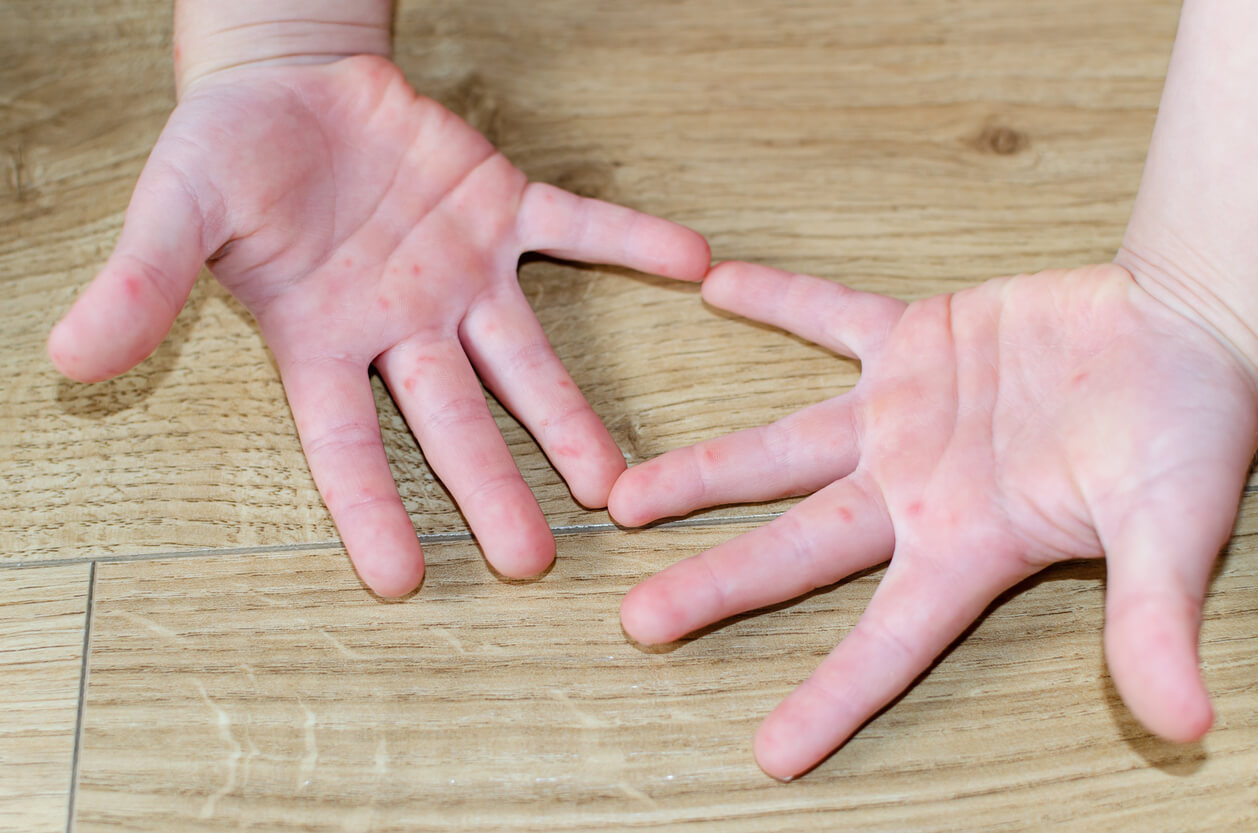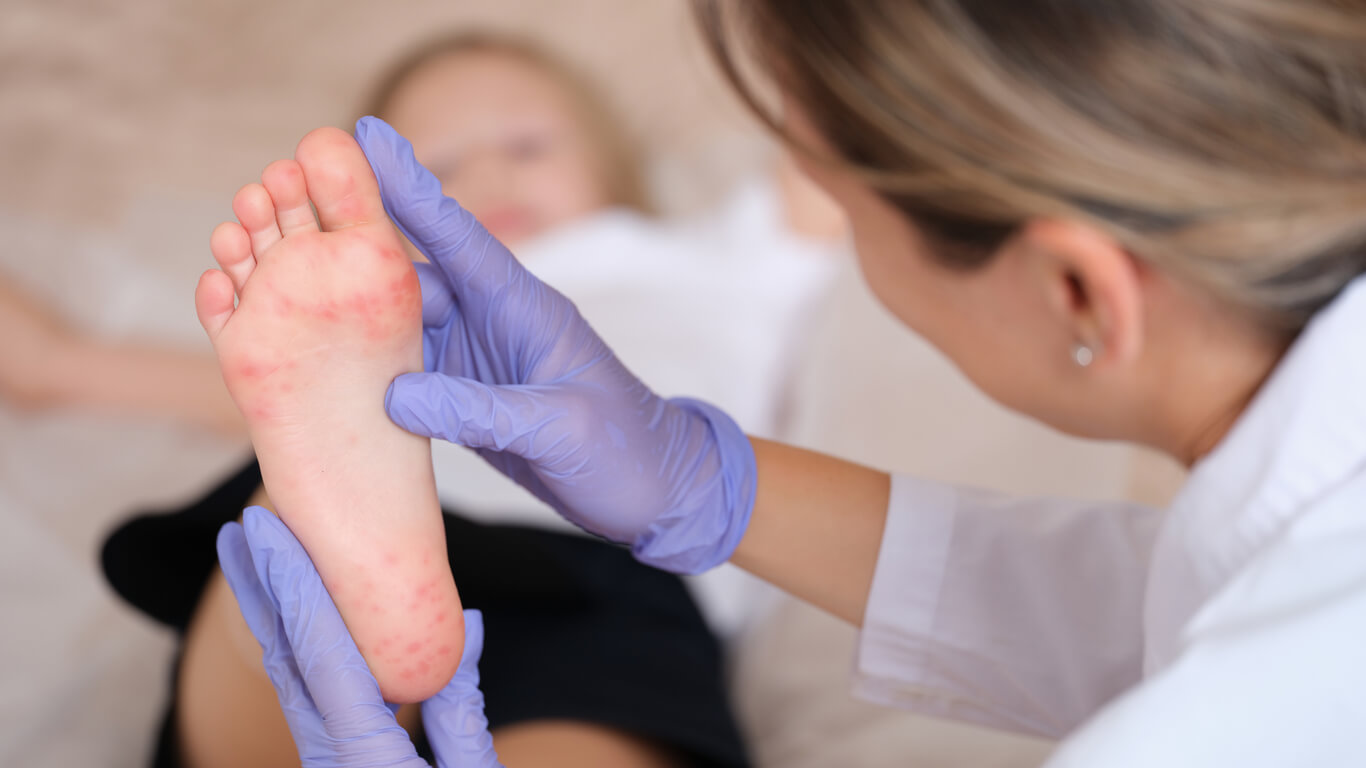Swimming Pool Pulpitis: What You Need to Know


Written and verified by the dermatologist Maria del Carmen Hernandez
Swimming pool pulpitis is a benign and relatively common condition affecting the skin of the hands and feet. In general, it occurs when in repeated contact with the rough surfaces of swimming pools.
It most often occurs in children because of the fragility of their skin and their habitual tendency to rub against the surface during play.
Why does swimming pool pulpitis occur?
Swimming pool pulpitis, or juvenile palmar dermatitis, is a contact dermatitis of the irritative type that manifests itself on the palms of the hands and soles of the feet of children. The skin of young children is characterized by skin fragility and immaturity. Therefore, added to the fact that they usually spend a lot of time in swimming pools, hyperhydration of the most superficial layer of the skin is generated by prolonged exposure to water.
Water dermatitis
Water dermatitis in swimming pools is caused by contact and is a type of allergy to the chemical products added to the swimming pool water. This condition can manifest itself on the skin that’s exposed to the water. It can even cause eczematous dermatitis due to the chemical products used for maintenance.
You may be interested in: Children with Skin Allergies: Symptoms and Recommendations

Atopic dermatitis
Children with atopic skin have a higher probability of developing swimming pool pulpitis. This occurs because of their altered epithelial barrier and associated immune dysregulation in the skin.
Atopic dermatitis is an intensely itchy, relapsing, and chronic condition. In general, it’s characterized by significant xerosis that creates an environment susceptible to different diseases or conditions. According to the American Academy of Dermatology Association, come recommendations for its correct management are the following:
- Warm (not hot) water baths.
- Limit bathing time to 5 to 10 minutes.
- Use mild, fragrance-free, hypoallergenic soaps.
- Gently pat the skin dry.
- Moisturize the skin constantly.
- Keep nails short and smooth.
Clinical manifestations of swimming pool pulpitis
Again, swimming pool pulpitis is a benign condition that appears in children as erythematous-violaceous, shiny macules. Moreover, these lesions aren’t itchy, don’t flake, and aren’t infiltrative. Their presentation is usually symmetrical on the higher areas of the palms of the hands, such as the thumbs of the fingers. In addition, the lesions are transient and resolve spontaneously.
It’s not uncommon to observe superficial erythema and blisters on the palms of the hands and soles of the feet, which are the areas that came into contact with the rough surface of the pool.
How is juvenile palmar dermatitis diagnosed?
In general, with only observation by parents or an adult caregiver, a diagnosis of certainty can be made quickly. However, sometimes the lesions often go unnoticed by parents and resolve spontaneously in children.

Therapeutic management of swimming pool pulpitis
Swimming pool pulpitis is a disease that’s part of the pediatric dermatoses of physical origin, in which slide friction dermatitis can also be found. The lesions generated on the thumbs of the fingers don’t require any medical treatment, as they disappear spontaneously and without sequelae.
Indications to consider
The indications include cessation of prolonged exposure to swimming pool water. At the same time, although it doesn’t usually appear with added symptoms, sometimes the irritation is considerable and may bother the child. Therefore, if the condition is significant, proper moisturizing with a mild moisturizing cream is required.
In turn, if the inflammation is greater, a low-potency corticosteroid cream can be administered to reduce the cutaneous manifestations more quickly.
Read also: 10 Tips for Treating Contact Dermatitis in Children
Swimming pool pulpitis and its severity
While swimming pool pulpitis may be relatively common, it’s often an underdiagnosed and unknown condition. In fact, it’s not a serious condition or one that significantly alters a child’s health. In short, parents shouldn’t be alarmed, as it resolves on its own.
Swimming pool pulpitis is a benign and relatively common condition affecting the skin of the hands and feet. In general, it occurs when in repeated contact with the rough surfaces of swimming pools.
It most often occurs in children because of the fragility of their skin and their habitual tendency to rub against the surface during play.
Why does swimming pool pulpitis occur?
Swimming pool pulpitis, or juvenile palmar dermatitis, is a contact dermatitis of the irritative type that manifests itself on the palms of the hands and soles of the feet of children. The skin of young children is characterized by skin fragility and immaturity. Therefore, added to the fact that they usually spend a lot of time in swimming pools, hyperhydration of the most superficial layer of the skin is generated by prolonged exposure to water.
Water dermatitis
Water dermatitis in swimming pools is caused by contact and is a type of allergy to the chemical products added to the swimming pool water. This condition can manifest itself on the skin that’s exposed to the water. It can even cause eczematous dermatitis due to the chemical products used for maintenance.
You may be interested in: Children with Skin Allergies: Symptoms and Recommendations

Atopic dermatitis
Children with atopic skin have a higher probability of developing swimming pool pulpitis. This occurs because of their altered epithelial barrier and associated immune dysregulation in the skin.
Atopic dermatitis is an intensely itchy, relapsing, and chronic condition. In general, it’s characterized by significant xerosis that creates an environment susceptible to different diseases or conditions. According to the American Academy of Dermatology Association, come recommendations for its correct management are the following:
- Warm (not hot) water baths.
- Limit bathing time to 5 to 10 minutes.
- Use mild, fragrance-free, hypoallergenic soaps.
- Gently pat the skin dry.
- Moisturize the skin constantly.
- Keep nails short and smooth.
Clinical manifestations of swimming pool pulpitis
Again, swimming pool pulpitis is a benign condition that appears in children as erythematous-violaceous, shiny macules. Moreover, these lesions aren’t itchy, don’t flake, and aren’t infiltrative. Their presentation is usually symmetrical on the higher areas of the palms of the hands, such as the thumbs of the fingers. In addition, the lesions are transient and resolve spontaneously.
It’s not uncommon to observe superficial erythema and blisters on the palms of the hands and soles of the feet, which are the areas that came into contact with the rough surface of the pool.
How is juvenile palmar dermatitis diagnosed?
In general, with only observation by parents or an adult caregiver, a diagnosis of certainty can be made quickly. However, sometimes the lesions often go unnoticed by parents and resolve spontaneously in children.

Therapeutic management of swimming pool pulpitis
Swimming pool pulpitis is a disease that’s part of the pediatric dermatoses of physical origin, in which slide friction dermatitis can also be found. The lesions generated on the thumbs of the fingers don’t require any medical treatment, as they disappear spontaneously and without sequelae.
Indications to consider
The indications include cessation of prolonged exposure to swimming pool water. At the same time, although it doesn’t usually appear with added symptoms, sometimes the irritation is considerable and may bother the child. Therefore, if the condition is significant, proper moisturizing with a mild moisturizing cream is required.
In turn, if the inflammation is greater, a low-potency corticosteroid cream can be administered to reduce the cutaneous manifestations more quickly.
Read also: 10 Tips for Treating Contact Dermatitis in Children
Swimming pool pulpitis and its severity
While swimming pool pulpitis may be relatively common, it’s often an underdiagnosed and unknown condition. In fact, it’s not a serious condition or one that significantly alters a child’s health. In short, parents shouldn’t be alarmed, as it resolves on its own.
All cited sources were thoroughly reviewed by our team to ensure their quality, reliability, currency, and validity. The bibliography of this article was considered reliable and of academic or scientific accuracy.
- Novoa A, Klear S. Pool palms. Arch Dis Child. 2016 Jan;101(1):41. doi: 10.1136/archdischild-2015-309633. Epub 2015 Sep 30. PMID: 26424817.
- Morgado-Carrasco D, Feola H, Vargas-Mora P. Pool Palms. Dermatol Pract Concept. 2019 Dec 31;10(1):e2020009. doi: 10.5826/dpc.1001a09. PMID: 31921496; PMCID: PMC6936631.
- Langan SM, Irvine AD, Weidinger S. Atopic dermatitis. Lancet. 2020 Aug 1;396(10247):345-360. doi: 10.1016/S0140-6736(20)31286-1. Erratum in: Lancet. 2020 Sep 12;396(10253):758. PMID: 32738956.
This text is provided for informational purposes only and does not replace consultation with a professional. If in doubt, consult your specialist.








